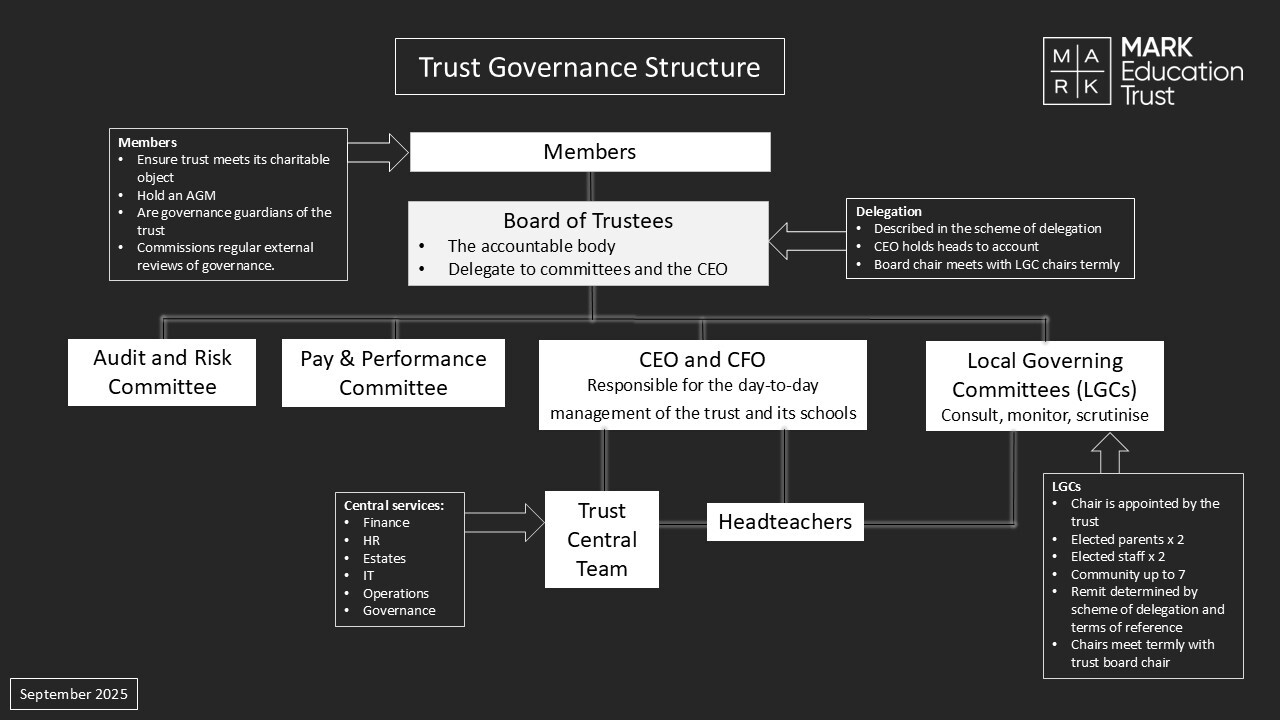- Home
- About Us
- Governance
Governance
The graphic below details the governance structure. In academy trusts the accountable body is the board of trustees.
Trustees decide which governance functions can be delegated including to school level. MARK Education Trust’s board of trustees has decided that each school in the trust should have a local governing committee. The role and responsibilities of each layer of governance is detailed in a scheme of delegation.

General principles the trust commits to:
-
The separation of individuals on each tier in the governance structure as this enables it to demonstrate transparent decision making and prevent bias and conflicts from emerging, thus strengthening the governance checks and balances within the trust.
-
Demonstrating the value it puts on local governance by ensuring effective channels of communication between trustees and local governing committees.
-
Providing trust specific induction and ongoing training and development programmes for all those involved in the governance of the trust.
-
Holding at least one meeting a year for all those involved in the governance of the trust.
The members of the trust are guardians of the governance of the trust and ensure that it carries out its charitable purpose.
There must be at least three members, although the trust aims to have at least five; members are not permitted to be employees of the academy trust and ideally not also trustees.
The members agree the trust’s articles of association, appoint trustees and appoint the trust’s external auditors.
The members receive information about the trust’s business and meet at least annually to receive the annual report and accounts. If they have concerns that the trust is not carrying out its charitable purpose, members may remove trustees that are failing to fulfil this responsibility.
To read more about our members please click here.
The trust is a charitable company and so trustees are both charity trustees (within the terms of section 177(1) of the Charities Act 2011) and company directors (within the terms of the Companies Act 2006).
Trustees are bound by both charity and company law.
Trustees are responsible for the general control and management of the trust, and in accordance with the provisions set out in the trust’s memorandum and articles of association, and its funding agreement; they are legally accountable for all statutory functions and for the performance of all the schools within the trust.
The board of trustees approves both a written scheme of financial delegation and this scheme of delegation, along with committee terms of reference.
The trust creates information pathways between the trust board, the local governing committees and the senior executive leader so that the LGCs can share with them any concerns (or celebrations) they may have.
To read more about our trustees please click here.
Trustees delegate some governance functions to two main board committees:
- The Resources Audit and Risk Committee (RAR) - Viral Desai (Chair)
- The Quality of Education and Standards Committee (QES) - Paul Ferrie (Chair)
Board committees have at least three trustees in membership, and trustees must be in the majority for voting purposes.
Board committees generally consist of at least five trustees; other members can be co-opted (for example, to fill skills gaps) but they will not have voting rights.
The trust board appoints the board committee chairs and committee members according to their skills.
The trust board reviews the committees’ terms of reference and membership annually.
Trustees delegate some governance functions to LGCs; the articles of association do not require trustee membership of LGCs.
LGCs consist of up to nine LGC members as follows:
- Two elected parents, two elected staff, a minimum of three and a maximum of five community members.
The term of office is usually four years but this can be varied by agreement with the chair of trustees. A term can be renewed once, limiting service to a maximum of eight years.
The academy’s headteacher does not sit on the LGC but attends and reports to the LGC.
The trust board appoints the LGC chairs annually and will also approve the appointment of the majority of LGC members.
The trust board reviews the LGC terms of reference annually.
The LGC is close to and representative of the community the school serves, and as such is:
- A valued point of consultation and representation in the development of trust policies,
- The recipient of detailed information about how their school is being managed and is tasked with the scrutiny of this thus providing assurance to trustees that the school is: - operating within the ethos and values of the trust and creating a positive climate for all stakeholders, - working within agreed policies, - is a safe place for students and staff, - is working effectively to achieve its ambitions for student outcomes, - is engaging with and listening to stakeholders.
- LGC members are also expected to be an ambassador for their school and the trust.
To view Beacon Academy Local Governing Committee information please click here
To view Uplands Academy Local Governing Committee information please click here
The trustees delegate the day-to-day management of the trust to the senior executive leader, line managing them in line with the trust’s appraisal and performance management policies.
The senior executive leader is also the accounting officer and so is not only responsible for the performance of the trust as a whole, but has a personal responsibility to parliament for the regularity, propriety and value for money, and for assuring the board about compliance with the funding agreement and the Academy Trust Handbook.
The senior executive leader is responsible for the leadership and management of the central services team, and the schools’ headteachers.
The senior executive leader reports to the trust board and its committees.
The senior executive leader of MARK Education Trust is Anna Robinson. For further information, read the Message from the CEO.